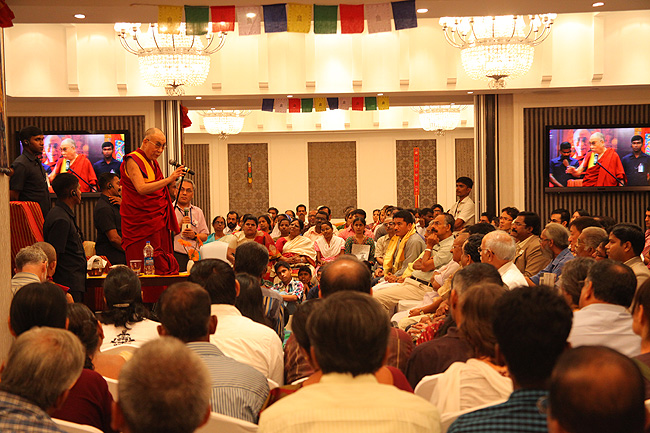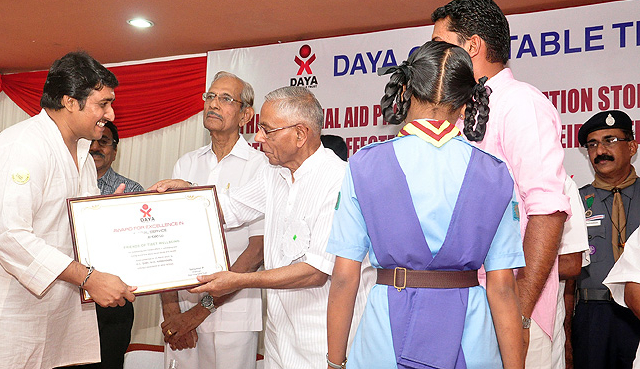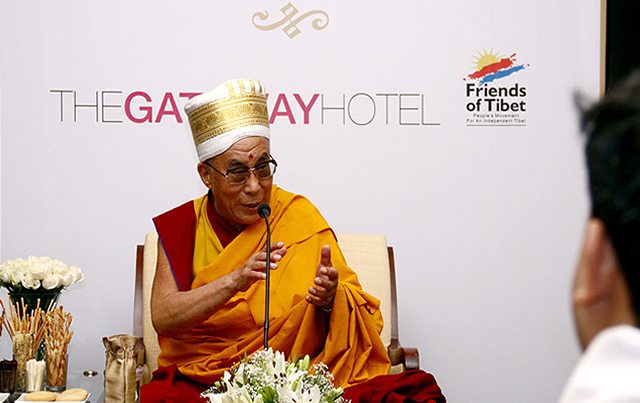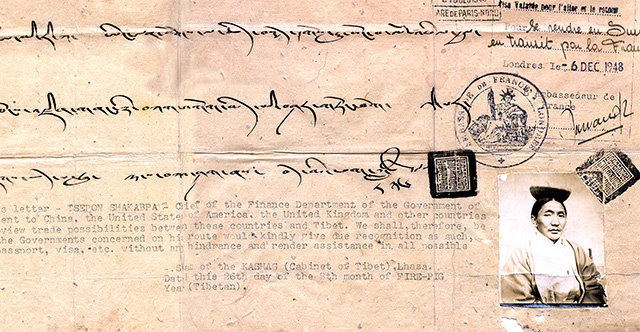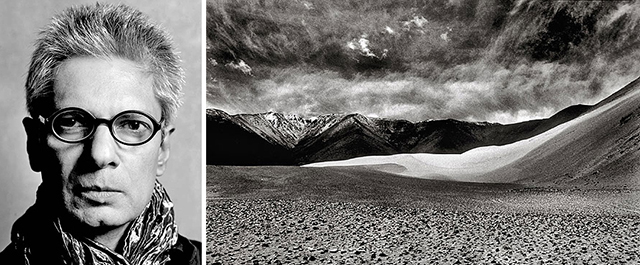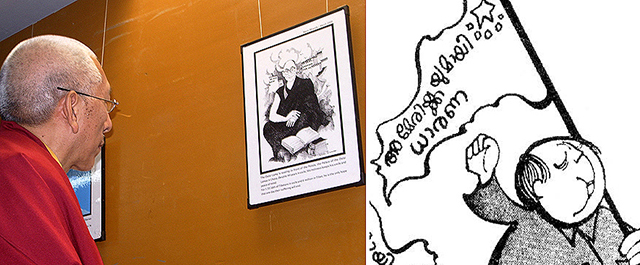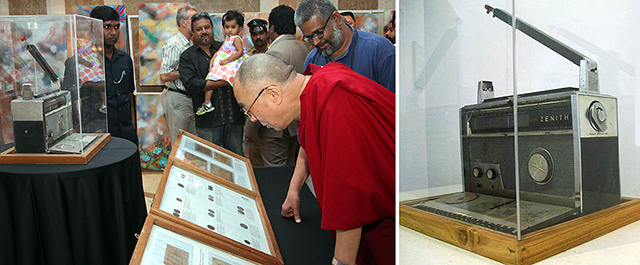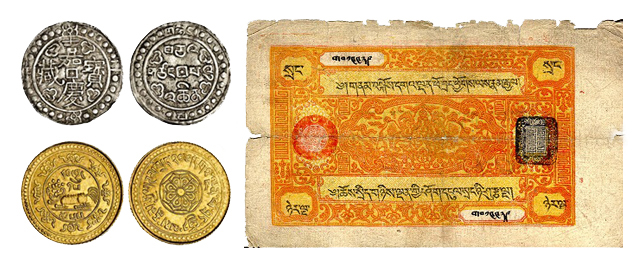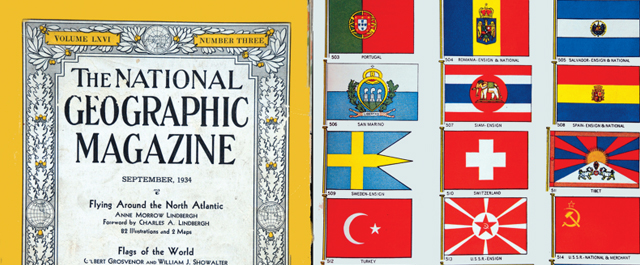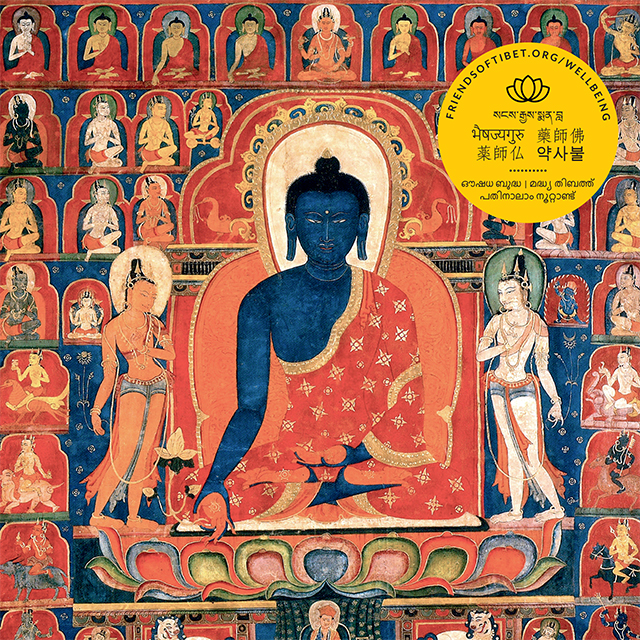| WHY TIBET | WHY BOYCOTT | HUMAN RIGHTS | REPORTS | PHOTOS | VIDEOS | DONORS |
| TIBET FOUNDATION | TIBET RESEARCH | SRI AUROBINDO ON TIBET | OSHO ON TIBET | WORLD TIBET DAY |
⋯
|
Friends of Tibet Foundation: An Initiative for the Restoration, Propagation and Promotion of Endangered Traditions and Practices of Tibet
FRIENDS of Tibet Foundation, a Charitable Trust (Regn No: 126/IV/2021) is the philanthropic wing of Friends of Tibet, a non-profit organisation founded in 1999. The primary objective of the Foundation is to support the conservation and promotion of Tibet's tangible and intangible heritage including healing traditions. Friends of Tibet Foundation is also engaged in conducting research on the unique heritage, legacy and history of Tibet and publishing varied research papers with the collaboration of scholars, academicians, scientists, holistic health educationists and sociologists.
His Holiness the XIV Dalai Lama of Tibet addressing a gathering of Friends of Tibet Foundation in 2012 //
Honorable Governor of West Bengal and former National Security Advisor HE Shri MK Narayanan presents 'Award for Excellence in Social Service' to 'Friends of Tibet Foundation' for its "outstanding and tireless efforts in addressing and raising awareness about social issues and causes". Shri Eswar Anandan from Friends of Tibet Foundation receives the award on the behalf of the organisation at a function organised on March 15, 2014. //
September 4, 2010: HH the XIV Dalai Lama of Tibet addressing a gathering of Friends of Tibet Foundation. //
THE historic 'Shakabpa Passport' was issued by the then Government of Independent Tibet in 1947 to the Finance Secretary Tsepong Wangchuk Dedhen Shakabpa who was leading a trade delegation to China, the United States and Britain. On this passport, visa and transit visa were issued by countries like the United States, Britain, India, France, Italy, Switzerland, Saudi Arabia and Egypt. However, this document got lost from the Tibetan community in 1992 and there were rumours that it had been sold to antique dealers and reached into the hands of Chinese government officials. After 13 years of mystery and search, Friends of Tibet located the historic passport with an antique dealer in Nepal, and later bought it for an undisclosed amount and was later presented to HH the XIV Dalai Lama in 2004. Today this document remains to stand as an important proof of independent status of Tibet legally recognised by other countries before China's invasion of Tibet in 1949.
The historic Tsepon Wangchuk Deden Shakabpa Passport of 1947 // More about Shakabpa Passport
A Brief History of the 1947 Tsepon WD Shakabpa Passport: The Tibetan government issued its own passports to travelers entering its borders or (the few) Tibetans who traveled abroad. Before WWII, the term passports covered visas and travel documents in general. The earliest record of a Tibetan passport issued to a foreign traveler is in 1688 to an Armenian merchant, Johannes. The Tibetan government gave its approval for the first-ever Everest expedition (1921). Charles Bell, the visiting British diplomat in Lhasa wrote "I received from the Tibetan Government a passport in official form, which granted permission for the climbing of Mount Everest." The subsequent Everest expeditions of 1922, 1924 and 1936 also received passports from the Tibetan government. Passports were sometimes issued for scientific undertakings: the Schaeffer expedition of 1939, Tucci's expedition of 1949 and the plant hunter Frank Kingdon Ward in 1924. President Roosevelt's two envoys to Tibet in 1942 were presented their passports at Yatung. The Americans Lowell Thomas Jr and Sr visited Tibet in 1949, and were issued "Tibetan Passports" at Dhomo. "When the Dalai Lama's passport was spread out before us, I could not help thinking that many Western explorers who had failed to reach Lhasa would have highly prized a document like this." The first modern Tibetan passport with personal information, photograph and space for visas and endorsements was issued in 1948 to members of the Tibetan trade mission. It was modeled on the international one-page fold-out model of 1915. Britain, USA and seven other countries issued visas and transit visas for this document. ◼
Prabuddha Dasgupta (1956-2012) //
THE Photography Collection of Friends of Tibet Foundation consists of original high-resolution masterpieces of well-known international photographers — Angel Lopez Soto (Spain), Angus McDonald (Australia), Ashwini Bhatia (India), Brian Harris (Canada), Diane Barker (UK), Jaqueline Meier (Switzerland), John Ackerly (USA), Giulia Francesca Johnson (USA), Lobsang Wangyal (Tibet), Kathryn Culley (USA), Manuela Metelli (Italy), Ken Damy (Italy), Nancy Jo Johnson (USA), Prabir Purkayastha (India), Prabuddha Dasgupta (India), Raghu Rai (India), Sonam Zoksang (USA), Suresh Natarajan (India), Vijay Kranti (India), Vikas Khot (India), T Wachs (USA) and William Chapman (USA).
The Friends of Tibet Foundation Photography Collection photograph of a solitary young Buddhist monk walking across a vast expanse of land in Ranbirpura in Ladakh titled 'Awakening the World' by Prabuddha Dasgupta (1956-2012), legendary photographer from India. The signed 1995 special edition photograph was gifted to His Holiness the Dalai Lama by Prabuddha Dasgupta on March 12, 2000. ◼
Rev Prof Samdhong Rinpoche, Prime Minister of the Tibetan Government-in-Exile looking at the Friends of Tibet Foundation Collection of Cartoons (August 25, 2005) //
ORIGINALLY developed as a travelling exhibition for Friends of Tibet, 'Indian Cartoonists on Tibet' is a selection of cartoons on the Tibet issue (1950-2005) and the tumultuous Indo-Chinese relations by renowned Indian cartoonists. The exhibition is narrated by Claude Arpi, French Tibetologist and the author of 'The Fate of Tibet'. The collection depicts 55 tumultuous years of the history of the Buddhist leader's lost state — Tibet, the Roof of the World sandwiched between two Asian giants — India and China. Tibet had the reputation of being the last Shangrila on earth. The Friends of Tibet Foundation Cartoon Collection includes work of renowned Indian cartoonists — OV Vijayan, Mario Miranda, Rajinder Puri, Priya Raj, Nanda Soobben, Prakash Shetty, Yesudasan, Abe Gowda, Kaak, Madhu Omalloor, Balu, Thommy, Ponnappa, Morparia are amongst others. ◼
His Holiness the XIV Dalai Lama of Tibet looking at the collection of Friends of Tibet Foundation artefacts in 2012, Sethu Das, founder of Friends of Tibet next to him. //
THE Friends of Tibet Foundation Collection of Tibet Artifacts include the historic Tsepon WD Shakabpa Passport (1947) issued by the then Government of Independent Tibet to the Finance Minister Tsepong Wangchuk Dedhen Shakabpa with stamped visa and transit visa issued by the United States, Britain, India, France, Italy, Switzerland, Saudi Arabia and Egypt; The 1934 edition of the National Geographic with Tibet National Flag along with 76 other national flags of independent countries; the Dalai Lama�s Zenith Royal 1000-1 Wavemagnet Transistor by the Zenith Corp, Chicago, USA and used by HH the XIV Dalai Lama back in Tibet and in exile in India; true Currency and Tangka Coins from ancient Tibet — commodities that are legal proofs of a nation's sovereignty. ◼
True Currency and Tangka Coins from Ancient Tibet: Part of the XIII Dalai Lama's modernisation strategy was to produce coinage and currency notes — commodities that are legal proofs of a nation's sovereignty. Since mining was undeveloped on the plateau, silver and copper were imported from India. In 1925 two officials were sent to Calcutta from the National Mint in Yatung, Chumbi Valley, to learn the skills to produce indigenous paper currency. Then, in 1930, a new Tibetan Government department was established to merge the mint, the paper currency press, and the ammunition factory. //
The 1934 edition of the National Geographic Magazine publishes 'Flags of the World' showing 77 independent countries including the Tibetan National Flag. It is assumed that The National Geographic Society obtained the Tibetan Flag from Tsarong Dasang Dadul, the Commander-in-Chief of the Tibetan Army and a member of the Geographic Society. Page number 383 of The National Geographic 1934 edition presents Tibet's National flag along with 77 flags of independent countries with a truthful description: "Tibet: With its towering mountain of snow, before which stand two lions fighting for a flaming gem, the flag of Tibet is one of the most distinctive of the East." //
DOWNLOAD: "Vision Wellbeing" (Malayalam | 11MB)
"For all the suffering beings in this world,
SOWA-RIGPA (Science of Healing), commonly known as the Tibetan System of Medicine is one of the oldest, living and well-documented medical traditions in the world. Sowa-Rigpa is a centuries-old traditional system encompassing spiritual, medical science and social behavior in the paradigm of holistic health. It is popularly believed that Tibetan Medical System is essentially a teaching of Buddha himself as part of the ways to liberate the human beings from the vicious cycle of suffering.
Tibetan System of Medicine has been originated from Tibet and popularly practised in India, Nepal, Bhutan, Mongolia and Russia. The majority of theory and practice of Sowa-Rigpa is similar to Ayurveda. The first Ayurvedic influence came to Tibet during 3rd century AD but it became popular only after the 7th century with the arrival of Buddhism in Tibet. Thereafter this trend of exportation of Indian medical literature, along with Buddhism and other Indian art and sciences were continued till the early 19th century. India being the birthplace of Buddha and Buddhism has always been a favourite place for Tibetan researchers and scholars for learning Buddhist art, culture and history.
Disease or imbalance is diagnosed mainly through pulse analysis, urinalysis and healthy interrogation and understanding of one's dietary and life style factors. Herbo-mineral formulations in the form of pills, powders, decoctions etc and several supplementary therapies are used to treat illness. Proper diet and lifestyle changes along with healthy mental attitude will be strongly emphasised. The Tibetan medical system is based upon a synthesis of Ayurveda, Unani, Greek, indigenous Tibetan, and Chinese medical systems. The Tibetan Medical System is practiced in Tibet, India, Nepal, Bhutan, Siberia, China and Mongolia, and more recently in parts of Europe and North America. The Tibetan Medical System embraces the traditional Buddhist belief that all illness ultimately results from the "Three Poisons" of the mind: Ignorance, Attachment and Aversion. Therefore, the mind, body and spirit play very crucial role in understanding and the treatment of diseases as a whole. Buddhist philosophy states that everything in the universe is in a constant state of flux — that all phenomenon are characterised by impermanence, and that the only permanent feature is impermanence itself. As Buddha said, "No matter whether perfect beings arise or not, it remains a fact, and a hard necessity of existence, that all creations are transitory." It is this impermanence that causes each and every being to suffer at one stage or another. Suffering is thus not accidental but springs from a specific cause, whether from this life or a previous life. Only through proper learning and the genuine practice of Dharma, one can liberate from the vicious cycle of suffering.
Tibetan Pulse Diagnosis The Tibetan medicines use purely natural herbal recipe that goes down to treat the root of the problem. These medicines are very safe as they are prepared without adulteration and known to have no side effects. In addition to many common ailments, Tibetan Medicines also offers very effective treatment in controlling and even curing major diseases like Asthma, Diabetes, Hypertension, General Cardio-Vascular problems, Nervous Disorders, Gynecological problems, Gastro-Intestinal Disorders, Chronic Cols and Allergic problems, Psychosomatic problems etc. The medicines also help in controlling primary cancer cases. Besides medicines, accessory therapies such as Golden Needle Therapy, Moxa-bustion and Bronze Cupping are being given to support the healing system. ◼
Frequently Asked Questions (FAQ)
1. What is the Tibetan Medical System?
2. What is the philosophy behind Tibetan Medical System?
3. How is the diagnosis done by a Tibetan Doctor?
4. What is Tibetan medicine most effective for?
5. Are there animal products or preservatives used in making Tibetan Medicines?
6. Is there a suggested way to take Tibetan medicine?
7. Are there side effects for Tibetan medicines?
8. What is the legal status of Men-Tsee-Khang, the Tibetan Medical Centre?
1. What is the typical Tibetan Medicine treatment for Cancer?
Tibetan medicine works best when there are no other intervening medicines. Efficacy is definitely reduced when it is combined with other treatments. So we advise patients to start our treatments after they have finished their chemotherapy. For example, a well-designed treatment strategy is more important than the strength or dosage of the medicines. Doctors try to understand individual body constitutions, recommend what food is needed and overcome deficiencies through supplements. Exercise also helps a lot.
I have also noticed that patients who are frustrated and mentally blocked impede the healing process. Patients who understand and accept the disease, have a positive outlook, take medicines in time and employ diet, lifestyle and the right state of mind, effectively aid their own recovery.
2. What dietary principles does Tibetan Medicine recommend for Cancer?
3. Is your success rate better for some types of cancers than others?
4. How does Tibetan Medicine work at different stages of the Cancer journey?
Friends of Tibet Foundation, PO Box 16674, Mumbai 400050, India.
⋯
Digital Support: Design & People, India + Ibiblio Digital Library & Archive Project, University of North Carolina, USA |
